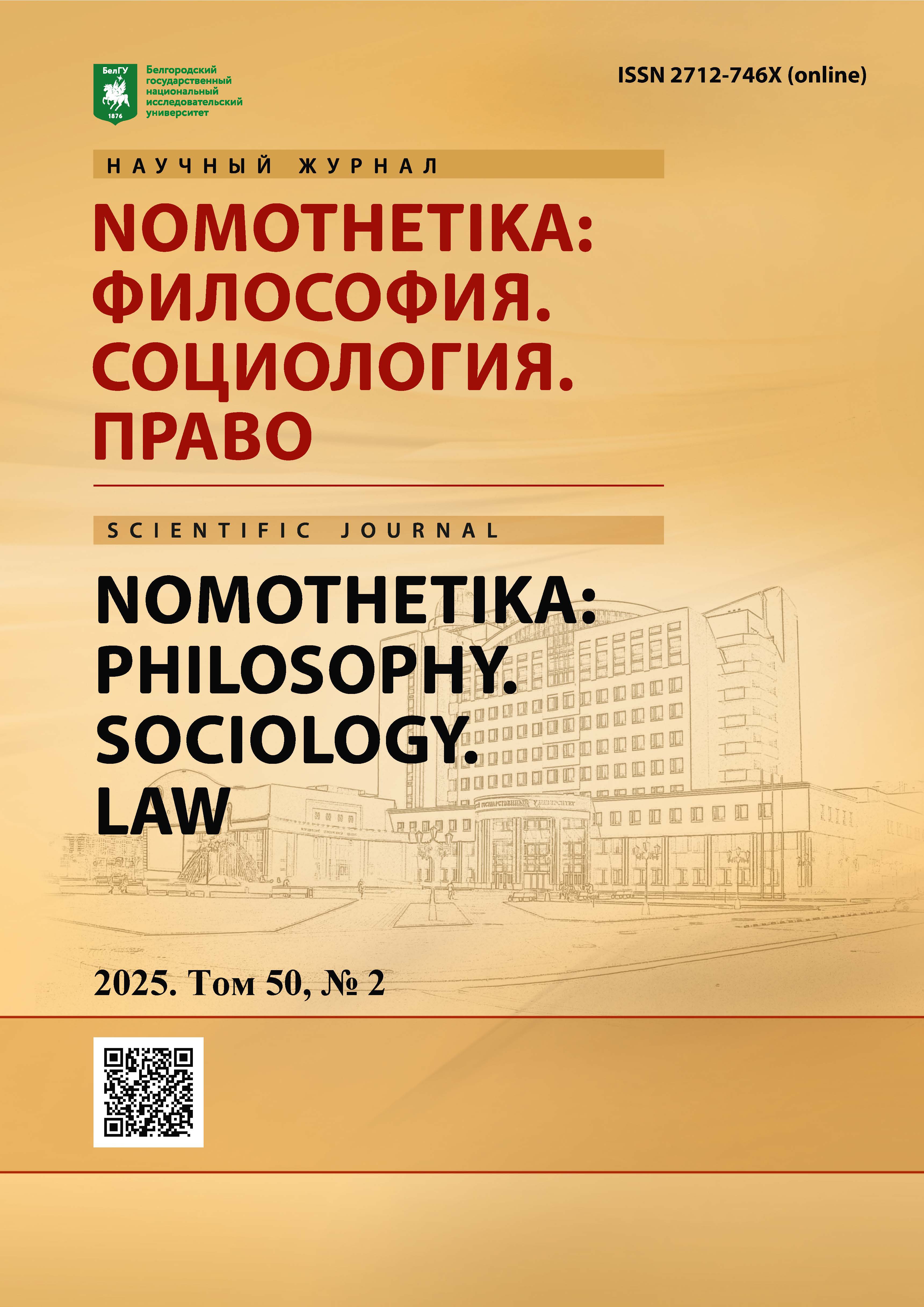Protection of the Earth as a Unique Form of Life: Philosophical and Legal Aspect
DOI:
https://doi.org/10.52575/2712-746X-2025-50-2-300-309Keywords:
рhilosophy of law, Gaia, biosphere, noosphere, ecocentrism, nature rightsAbstract
Based on a deep study of James Lovelock's Gaia hypothesis, Vladimir Vernadsky's concepts of the biosphere and noosphere, as well as the ideas of Lynn Margulies, Dorion Sagan and others, the article proves the need for a fundamental rethinking of the concept of environmental law in the context of global environmental and pandemic crises. Attention is focused on the philosophical aspects of international and national law related to the transition from an anthropocentric to an ecocentric paradigm. The necessity of recognizing the Earth as a unique form of life with its own interests and values independent of humans is argued. The author notes that environmental pollution, the climate crisis and other global challenges require the international community to form a new philosophical and legal paradigm based on respect for the integrity of the biosphere and an understanding of the interdependence of man and nature.
Downloads
References
Список литературы
References
Баркова Э.В. 2016. К истории экофилософии: голос одухотворенного мира в гармонии взаимодействия человечества и природы в концепции В.С. Соловьева. Человеческий капитал, 8: 8-11.
Barkova E.V. 2016. Towards the History of ecophilosophy: the voice of the spiritualized world in the harmony of the interaction of humanity and nature in the concept of V.S. Solovyov. Human Capital, 8:8-11.
Дмитриева Н.В. 2012. Современное состояние проблемы взаимоотношения природы – человека –общества: социально-философский анализ. Вестник Саратовского государственного технического университета, 1-1: 170-175.
Dmitrieva N.V. 2012. The current state of the problem of the relationship between nature – man – and society: a socio-philosophical analysis. Bulletin of Saratov State Technical University, 1-1:170-175.
Турчин М.Б. 2011. Экофилософская методология как конструирующий фактор течения радикального экологизма. Гуманитарный вестник ЗДИА, 47: 105-113.
Turchin M.B. 2011. Philosophical methodology as a constructive factor in the course of radical environmentalism. ODIA Humanitarian Bulletin, 47:105-113.
Шульга Е.Н. 2018. Экофилософия и символический мир природы: проблема интерпретации. Logos et Praxis, 17-1: 22-31.
Shulga E.N. 2018. Ecophilosophy and the symbolic world of nature: the problem of interpretation. Logos and Practice, 17-1:22-31.
Álvarez-Rondón C.C. 2025. Derechos de la naturaleza en Colombia: dispositivos e instrumentos de gestión ambiental de la administración pública desde una perspectiva de innovación. DIXI, 27: 1-16.
Cardozo D.E., Salles A.A. 2019. Animal Rights Theory from the Legal and Bioethical Perspectives Derecho Animal (Forum of Animal Law Studies), 10/3: 30-46.
Gare A. 2017. From ‘Sustainable Development’ to ‘Ecological Civilization’: Winning the War for Survival. Cosmos and History: The Journal of Natural and Social Philosophy, 13-3: 130-153.
Kim R.E. 2022. Taming Gaia 2.0: Earth system law in the ruptured Anthropocene. The Anthropocene Review, 9-3: 299-590.
Kopytin A., Gare A. 2023. Ecopoiesis: A Manifesto for Ecological Civilization. Ecopoiesis: Eco-Human Theory and Practice, 4-1: 6-17.
Litfin K. 2005. Gaia Theory: Intimations for Global Environmental Politics. Handbook of Global Environmental Politics. Editor: P. Dauvergne. Elgaronline, 502-517.
Lovelock J. 1979. Gaia: A New Look at Life on Earth. Oxford University Press, 157 p.
Lovelock J. 1988. The Age of Gaia A biography Our Living Earth. New York; London: Norton, Cop., 255 p.
Maldonado D.B. 2019. El constitucionalismo radical ambiental y la diversidad cultural en América Latina. Los derechos de la naturaleza y el buen vivir en Ecuador y Bolivia. Revista Derecho del Estado, 42: 3-23.
Margulis L. 1997. Microcosmos: Four Billion Years of Microbial Evolution. University of California Press, 301 p.
Margulis L., Sagan D. 2024. Gala and Philosophy. Silver Press, 80 p.
Margulis L., Sagan D., Niles E. 1995. What is life? New York: Simon & Schuster, 207 p.
Paola M.D., Jamieson D. 2018. Climate Change and the Challenges to Democracy. University of Miami Law Review, 72: 369-424.
Serafin R. 1987. Vernadsky's Biosphere, Teilhard's Noosphere, and Lovelock's Gaia: Perspectives on Human Intervention in Global Biogeochemical Cycles. IIASA Working Paper. IIASA, Laxenburg, Austria, 1987. 12 p.
Stoa R. 2015. Droughts, Floods, and Wildfires: Paleo Perspectives on Disaster Law in the Anthropocene. Georgetown International Environmental Law Review, 27: 393-446.
Stone C.D. 1972. Should Trees Have Standing? Toward Legal Rights for Natural Objects. Southern California Law Review, 45-2: 450-501.
Stutzin G. 2002. Nature’s Rights: Justice Requires that Nature Be Recognised as a Legal Entity. Resurgence & Ecologist, 210: Jan./Feb.
Webster K. 2013. Missing the wood for the trees: systemic defects and the future of education for sustainable development. The Curriculum Journal, 24-2: 295-315.
Vernadsky V.I. 1998. The Biosphere. Copernicus, 195 p.
Vernadsky V.I. 1945. The Biosphere and the Noosphere. American Scientist, 33-1: 1-12.
Abstract views: 104
Share
Published
How to Cite
Issue
Section
Copyright (c) 2025 NOMOTHETIKA: Philosophy. Sociology. Law

This work is licensed under a Creative Commons Attribution 4.0 International License.


